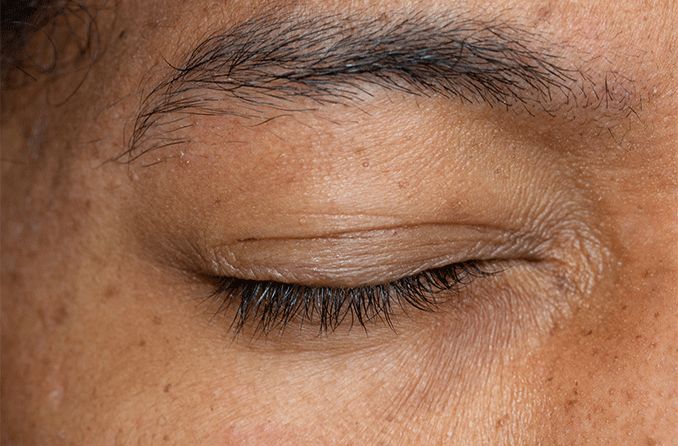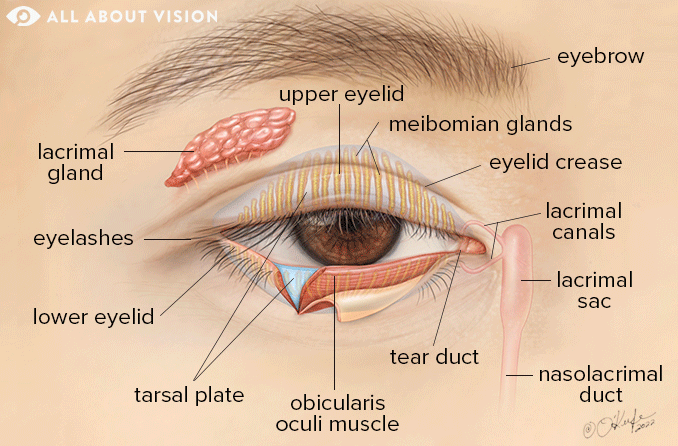Eyelid: Parts of the eyelid and how they work

Eyelids have one of the most important jobs in the human vision system. Without eyelids, our eyes would have no protection from impacts, infections and the harsh rays of the sun.
The upper and lower eyelids use skin, muscles, glands, nerves and other tissues to keep the eyes mobile, moist and lubricated. Reflexes close the eyelids quickly to prevent injuries. Eyelids cannot close quickly enough for every hazard, though. This is why so many professions and activities require eye protection.
A quick overview of the key parts of the eyelids will help you understand why they are so important to the vision system.

Illustrated by Laurie O'Keefe
Eyelashes — The eyes’ first line of defense
Let’s start with the little hairs sticking out from the upper and lower eyelids. Eyelashes have a bunch of important jobs:
Keeping water and sweat out of the eyes.
Triggering a reflex to close the eyelids when insects and other threats get too close.
Capturing dust particles and other pollutants to keep them away from the eyeballs.
Keeping the eyes lubricated by reducing the evaporation of tears.
Adding an extra line of defense when the eyelids close.
Eyelashes might just seem like an excellent foundation for cosmetics, but their role in vision is fundamental. Indeed, all sorts of animals also have eyelashes, suggesting they have provided a survival advantage over millions of years of evolution.
SEE RELATED: Epiblepharon
The skin — Outer layer of the lower and upper eyelids
A thin layer of skin covers the eyelids. The subcutaneous layer lies directly below the skin.
These skin layers protect everything beneath — muscles, nerves and glands — from infection, abrasion and other risks.
Unlike most of your body’s skin, eyelid skin has little or no fat in the subcutaneous layer. This makes the eyelid more prone to swelling and bruising. That’s why getting in a fistfight produces the famous “black” eye if a punch hits the eye socket.
READ MORE: Eyelid cancer: Types, symptoms and treatments
Conjunctiva — The eyes’ invisible lubrication layer
The conjunctiva is a see-through layer that helps with vision in two places:
The innermost layer of the eyelids.
The white of the eye (also called the sclera).
The conjunctiva keep the eyes moist, lubricated and free of small matter and pollutants. Moisture and lubrication keep the eye surface healthy and make it easier for the eyeballs to move around. This prevents strain and discourages infections that place extra stress on the vision system.
READ MORE: Eyeball piercing
Muscles — The eye openers (and closers)
Muscles do the heavy lifting in the eyelids. They have four key functions:
Blinking reflexively for protection, lubrication and comfort.
Blinking voluntarily for things like closing the eyes extra tight or closing one eye to wink and signal something to somebody (like “I’m just kidding”).
Keeping the eyes protected during sleep.
Pushing tears through the tear duct system to maintain a constant flow of moisture.
Muscles function a bit differently in the upper eyelid and the lower eyelid but they all contribute to the same result — moving the eyelids where they need to be to protect the eyeballs.
SEE RELATED: Apraxia eyelid opening
Tarsus — The connective tissue that holds the eyelids together
The tarsus is tough, connective tissue that gives form to the eyelids. All of your eyelashes grow out of the upper and lower tarsus sections of the eyelids.
The natural shape of your eyelids happens because of the tarsus. It’s a dense, strong tissue similar to the tendons that attach muscles to bones.
How does the tarsus shape the eyelids? Well, the tarsis sits below the skin of the eyelid, almost like a frame, except that it’s made of living tissue The eyelid skin wraps across this foundation, which is firm enough to give form to the eyelids.
The tarsus also contains glands that are critical to the functioning of the vision system. We’ll cover glands next.
Glands — The tiny organs that keep everything running smoothly
Glands secrete substances that help the body function effectively. In our vision system, glands secrete liquids and lubricants. Meibomian glands, for instance, secrete oil to lubricate the surface of the eye. These glands in the tarsus help prevent evaporation of tears.
Glands in the eyelids also secrete oil around the follicles of the eyelashes and release sweat for evaporative cooling.
What about the tear glands? Most tears come from the lacrimal glands, which start a job that the eyelids finish.
Lacrimal glands are not part of the eyelid — they’re actually above each eye. These glands release tears into the eye socket and the eyelids distribute the tears over the front of the eye’s surface. Tear ducts carry away excess tears into the nasal cavity (this is why crying gives you a runny nose).
SEE RELATED: Pyogenic Granuloma
Nerves — The connectors for moving and feeling
It takes a lot of nerves to make your eyes blink properly. These nerves direct movement and provide sensation:
Movement. Three kinds of motor nerves send signals from the central nervous system that make the eyelids open and close.
The seventh cranial nerve, also called the facial nerve.
The third cranial nerve, also called the oculomotor nerve.
Sympathetic nerves, which cause reflex motions.
Sensation. Branches of the fifth cranial nerve (trigeminal nerve) extend to the surface of the eyelids, supplying sensations like touch, heat and itching.
The nerves that control your eyelids also influence the appearance of your face. If the eyes are the window of the soul, then the nerves of the eyelid keep that window open or closed.
Are you having trouble with your eyelids?
Blinking your eyes is as natural as breathing, so it’s easy to overlook the importance of the eyelids. Simply put, your eyelids need to stay healthy to protect your vision.
If you’re having issues with your eyelids, like pain, itchiness or excess mucus, it’s time to have an eye doctor check it out.
READ MORE: Monolids vs. double eyelids
Page published on Tuesday, February 2, 2021






